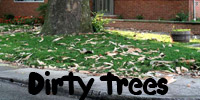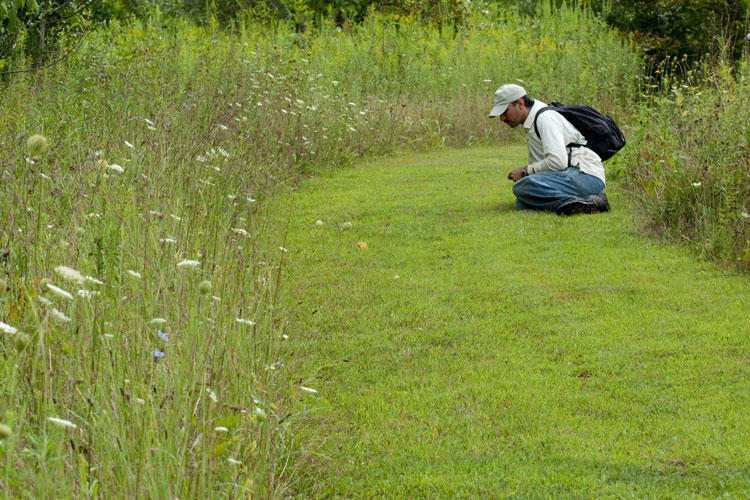




(Additional content at flickr Photostream and YouTube Channel)
If you have botany questions or comments please email BobK . Thanks!
August, 2009, Pickaway County, Ohio
(videos)
Hooray for August, when we see Ptilothrix bombiformis, the ground-nesting solitary bee associated with rose-mallow (Hibiscus moscheutos) plants at Stage's Pond State Nature Preserve in Pickaway County, Ohio. Pertinent aspects of Ptilothrix natural history were described in August 2008. As mentioned then, the bees construct pencil-wide vertical burrows in the dry soil of a path through a meadow near a rose-mallow marsh along prepositional phrases. Although dozens of individual female bees construct their burrows side by side, these are still considered "solitary" bees because they are not social insects like ants, honeybees and bumblebees, whose queen is the only reproductive female and there are sterile "workers" who all live together. Instead, each Ptilothrix female builds her own little nest, and every individual has the capacity to reproduce. They simply nest in groups as do, say, cliff swallows.
Here's a snapshot of the nest area, with a person included for scale. He's watching the bees come and go, while conjuring up scientific hypotheses about them, that could be tested without harming the bees.

Ptilothrix nest site: a path through a meadow near a pond in Ohio. August 23, 2009.
In
March I acquired a nifty new camera: the Canon EOS 5D Mark 2. This
is a digital single lens reflex (DSLR) camera with
a new
feature that is likely to become standard on DSLR's: the capacity
to shoot video. This is good because it
eliminates the need to lug around a whole other camera just in case a
subject turns up that's well suited for video. Also, DSLR
lenses come in many sizes, enabling macro or telephoto videos
that would be impossible using a consumer-grade camcorder, or
even the current generation i-phone. (Just wait
though. And expect a Ptilothrix
"app.") Shooting video is great fun.

Canon 5D Mark 2 --good for stills and video!
Here's an aerial view of a "neighborhood" of "bee city." Note how the bees quickly and inconspicuously enter and leave their burrows. At 3 minutes and 10 seconds into the clip, a notably plump, yellow one can be seen bringing pollen home. (Discussed further below.)
Athough I've
never observed it --Stage's pond is quite
large and ca. 100 meters from the nest site --hibiscus bee is famous
for standing water-strider-like on the water's surface and
drinking
water from it, then flying home and using the just-sipped
water to
moisten, and
thereby soften, the soil she
is burrowing into to place her nest. In the video below, observe how
the soil becomes wet (dark) as she works it with
her mouth.
Ptilothrix pushes
pesky
pellet. August 7, 2009.
Canon 5D Mark 2 --good for stills and video!
The
hibiscus bee moves around a lot and isn't very camera-shy
--she was made for movies!
Here's a video of the "bee city."
Here's a video of the "bee city."
As
swamp cicadas sing, Ptilothrix
females come and go to and from their nests.
Stage's Pond State Nature Preserve. Pickaway County, Ohio. August 14, 2009.
Stage's Pond State Nature Preserve. Pickaway County, Ohio. August 14, 2009.
Here's an aerial view of a "neighborhood" of "bee city." Note how the bees quickly and inconspicuously enter and leave their burrows. At 3 minutes and 10 seconds into the clip, a notably plump, yellow one can be seen bringing pollen home. (Discussed further below.)
Ptilothrix
nesting area at Stage's Pond. August 7, 2009.
Here, a bee initiates
nest construction by digging into the soil of a grassy path.
Ptilothrix
starts a new burrow at Stage's Pond. August 14, 2009.
As
a rufous-sided towhee and common yellowthroat serenade, Ptilothrix
constructs a nest-burrow, moistening the soil with pond water sipped earlier on August 14, 2009.
constructs a nest-burrow, moistening the soil with pond water sipped earlier on August 14, 2009.
The
most dramatic thing the hibiscus bee does during nest construction is
to toss little
balls of excavated soil away from the burrow using
her hind legs. The following gallery shows pictures taken
about 1/8 second apart. A dirt-ball is image-captured in mid-air.
Slideshow
of Ptilothrix
kicking soil out of her burrow.
Here's
a short video
of the same thing.
While
a song sparrow sings, Ptilothrix
kicks soil out of her burrow. August 7, 2009.
...and
here's a somewhat longer one. In the beginning, she seems to be having
trouble with a
pesky pellet!
At
another stage of construction, the bee moulds a chimney-like turret
about the entrance hole by pushing moist soil upwards with her abdomen.
Ptilothrix
moulds a chimney-like turret above her nest burrow. August
7, 2009.Here's
a closeup view.
Ptilothrix
shapes the soil around the entrance to her nest burrow.
Musical accompaniment by song sparrow and field sparrow. August 7, 2009.
Musical accompaniment by song sparrow and field sparrow. August 7, 2009.
When
burrow construction is complete, the hibiscus bee gathers
pollen from rose-mallow flowers. In typical Malvaceae fashion, hibiscus
flowers have a bottlebrush-like arrangement of numerous stamens
attached along a tube that surrounds the style. The five stigmas are
prominently
placed in the flight path of an approaching bee.
Here's a video montage of the pollen-gathering process. Note that, in one of the instances, Ms. bee, on her departure from the flower, clambers all over the stigmas, no doubt effecting self-pollination.
Here's a video montage of the pollen-gathering process. Note that, in one of the instances, Ms. bee, on her departure from the flower, clambers all over the stigmas, no doubt effecting self-pollination.
Hibiscus
bees gather pollen
from Hibiscus
moscheutos.
Stage's Pond State Nature Preserve, Pickaway County, Ohio. August 7, 2009.
Stage's Pond State Nature Preserve, Pickaway County, Ohio. August 7, 2009.
After
she's gathered enough pollen, and looking so cute --like a little
yellow flying
pop-pom --she makes a bee-line back home to sequester it away in the
burrow. (Later she'll lay an egg on the surface of the ball.)
Here's a video of a bee dropping down into her hole. At the end of the segment, she leaves to get more. Not much happens in the interim. You might just scroll ahead to the amazing climax.
Here's a video of a bee dropping down into her hole. At the end of the segment, she leaves to get more. Not much happens in the interim. You might just scroll ahead to the amazing climax.
Ptilothrix
delivers pollen, then goes off for more. August 14, 2009.
Often,
as shown above, they drop straight
into the burrow. But
here's
an instance of slight imprecision, where the bee lands some
distance from her burrow, then crawls over to it and enters on foot as
a song sparrow calls loudly.
Ptilothrix
somewhat clumbsily enters her burrow. August 14, 2009.
Somehow
the bees know which hole is theirs and avoid trespassing. Occassionaly
a mistake is made. Here a bee at home is merrily digging and tossing
dirt-balls. A second bee accidentally interlopes, then instantly
retreats. Apparently non-plussed, the rightful resident proceeds with
her
construction project.
A Ptilothrix
bee briefly
enters a neighbor's borrow, apparently by
mistake.
Stage's Pond State Nature Preserve. August 7, 2009.
Stage's Pond State Nature Preserve. August 7, 2009.
Apparently,
misunderstandings
about residency are not always quickly resolved.
Below, two Ptilothrix
females engage in direct conflict over who belongs there. They
alternately enter and then get dragged out by their adversary.
Yikes!
Stage's Pond, Pickaway County, Ohio. August 7, 2009.
Why did this conflict happen? I guess I had something to do with it. Maybe the accidental "intruder" departed from her neighboring nest hole several minutes earlier and, upon departure, imprinted its location in her little bee-brain relative to an odd 3-trunked "shrub" with a big black one-eyed "bird" perched atop it. While she was away, unbeknownst to her, the "shrub" moved to a neighboring nest hole. (I hate it when that happens!)

